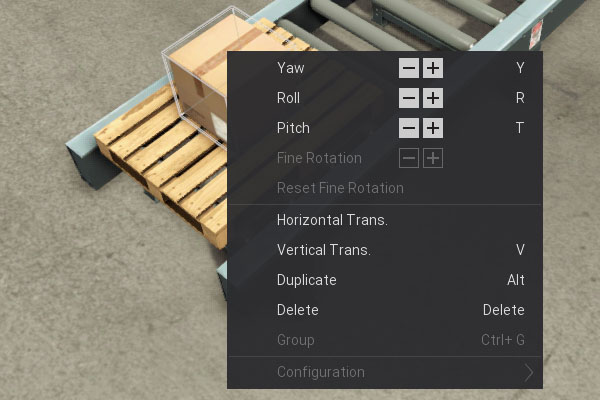Edit and Run¶
Factory I/O works in two different modes, Edit and Run mode. In Edit mode, you edit a scene by placing parts together and in Run mode, you simulate it in real-time. To switch between Edit and Run mode, click the Play (F5) button on the toolbar.
Edit Mode¶
In Edit Mode, you open, save, create and edit scenes. Scenes are designed by placing, transforming and modifying parts.
Creating¶
Parts are created by dragging them from the Palette into the 3D environment. Also, you can create a new part by duplicating an existing one: select a part, press and hold Alt and Drag the duplicated part to a new location. You can also copy and paste a part or group of parts, either on the same scene or between different scenes (Ctrl+C / Ctrl+V). Note that parts surrounded by a red bounding box are intersecting other parts and will be deleted if not placed correctly.
Selecting¶
Select a single part by Left-clicking on it. Alternatively, you may select several parts at once using the Rectangle Selection Tool: Left-click on the scene background and draw a rectangle intersecting all parts to be included in the selection. You can add or remove parts from a selection by holding Ctrl while selecting.
Deleting¶
Delete parts by selecting them and pressing Del.
Translating¶
Translate parts by Left-clicking and holding the Left Button. By default, parts are translated horizontally, to translate them vertically press V, hold the Left Button and drag. Factory I/O includes a smart collision algorithm which allows parts to be placed only at valid positions. This feature makes building a 3D scene a comfortable and natural experience.
Rotating¶
Rotate parts by pressing the Y to Yaw (rotation around the up axis), R to Roll and T to Pitch. Note that most parts allow only rotations of 90º, sensors can rotate freely around the local up axis. Parts surrounded by a red bounding box are intersecting other parts and will be deleted if not placed at a valid location.
Grouping¶
Parts can be grouped together to easily perform multiple operations at once. Select the parts you wish to group and press Ctrl+G to group them together. An individual part of a group can be selected by holding Ctrl and selecting it. To ungroup all parts, select the group and press Ctrl+G.
Configuration¶
Some parts include different configurations which can be selected from the Context Menu. Available configurations are typically related to how parts work (monostable, bistable, etc.) or the visual representation (color).
Context Menu¶
Most previous commands can be executed through the Context Menu. Right-click on a selection to show the Context Menu.

Run Mode¶
In Run mode, a scene is simulated in real-time and can be controlled manually or by an external controller (such as a PLC). A hand mouse cursor identifies parts that can be interacted with. Left-click and drag an interactive part to move it; press Shift to restrict movement to the horizontal plane, or V to translate vertically.
Pause¶
The simulation may be paused and resumed at any moment. Pausing a scene will hold the simulation at that instant of time allowing to check the state of each actuator and sensor and easing debug operations on the controller.
Slow Motion and Fast Forward¶
Additionally, a scene may be run in slow motion or fast forwarded. Slow motion allows to carefully analyze the behavior of actuators, sensors, and parts. It can be a very valuable tool, especially on scenes with fast-moving parts and items.
When fast forwarding the simulation you can validate the controller logic in a fraction of time. Additionally, it can be useful when generating large quantities of data is a requirement. However, caution is needed when using timers on controllers. Additionally, fast-moving parts may not be detected by sensors which makes the controller logic to fail.